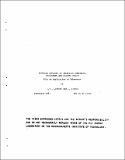Repeated auctions of incentive contracts, investment and bidding parity : with an application to takeovers
Author(s)
Laffont, Jean-Jacques; Tirole, Jean
DownloadMIT-EL-87-017WP-19573699.pdf (2.374Mb)
Metadata
Show full item recordAbstract
This paper considers a two-period model of repeated franchise bidding or
second sourcing. A regulator contracts with a single firm in each period,
presumably because of increasing returns to scale. The incumbent firm invests
in the first period. The investment may be transferable to a second source or
not; and may be monetary or in human capital. Each firm has private
information about its intrinsic efficiency, and, if it is selected to produce.
about the cost-reducing effort it exerts and the investment it makes. The
regulator, however, observes the firm's realized cost at the end of the period
(the cost includes monetary investments and may be random). In the second
period the incumbent firm can be replaced by an entrant. The regulator commits
to an optimal breakout rule.
The paper generalizes an earlier result that the optimal policy is to
regulate through contracts linear in cost overruns. It also derives
conclusions concerning the intertemporal evolution of incentive schemes.
Mainly, it puts emphasis on the issue of bidding parity. It shows that three
basic effects guide the optimal bias in the second-period auctioning process
and determines whether the incumbent should be favored depending on the nature
of investments. The outcome of the analysis is a relatively pessimistic
assessment of the desirability of second sourcing when sizeable investments
are at stake.
Last we reinterpret the second source as a raider, and the breakout as a
takeover. We discuss the desirability of defensive tactics, and obtain some
relationships between the size of managerial stock options, the amount of
defensive tactics, the firm's performance and the probability of a takeover.
Date issued
1987Publisher
MIT Energy Lab
Other identifiers
19573699
Series/Report no.
MIT-EL87-017WP